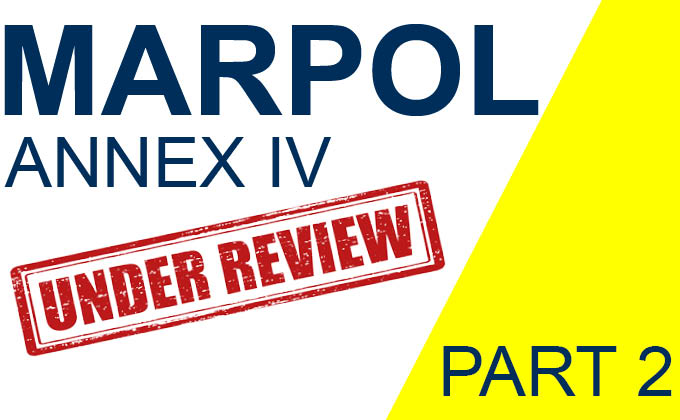MARPOL Annex IV is currently under revision by the IMO. We cover the most relevant topics in a multi-part article series:
PART 3: SEWAGE MANAGEMENT PLAN
Land-based wastewater treatment works (WWTW) serving our cities, towns, and villages turn raw sewage into clear effluent. They also produce an inevitable by-product called sewage sludge. All treatment methods produce sludge at some point, even if it is purely natural degradation. A major part of wastewater science and engineering concerns the characteristics, management, and sustainable recycling and disposal of sewage sludge.
CURRENT IMO REGULATIONS DON’T MENTION SEWAGE SLUDGE
But when it comes to sewage treatment onboard ships, the notion of sewage sludge does not exist in the IMO’s regulations – the MARPOL Annex IV. Without effective compliance monitoring, sewage sludge produced by the sewage treatment plants (STPs) has mostly been discharged into the STP effluent, making it ‘virtually raw sewage’ (MEPC 64/23, MEPC 67/8/1, MEPC 71/INF.22). So, to recognise, define and manage sewage sludge is essential.
THE REVISED MARPOL ANNEX IV WILL REGULATE SEWAGE SLUDGE
Relevant proposals under the revisions of MARPOL Annex IV and its guidelines include:
- the introduction of a sewage sludge definition,
- recording of sludge production during STP type approval tests,
- entries on sludge in the Sewage Record Book (SRB),
- management practices regarding sludge in the Sewage Management Plan (SMP),
- the introduction of a sludge holding tank and its moderate discharge rate,
- and alas, the Baltic countries can prohibit the discharge of sludge in MARPOL Annex IV Special Areas,
- and so on …
The scene is set, but the debate is far from over.
The necessity of a dedicated sludge holding tank reflected in the IMO sub-committee Pollution Prevention and Response (PPR 8/7 and PPR 9/14) has now been rolled back in PPR 10/12, without offering a compliant solution. Many hope the old ways of managing a sewage treatment plant are still OK for the future. This is expected when the root cause of the poor performance status of sewage treatment plants is left unexamined.
SEWAGE TREATMENT PLANTS AND SEWAGE SLUDGE: THE STATUS QUO
Some sewage treatment plants are designed to return their sludge to their feed tank. This does not conform to the IMO’s guidelines and mounts to cheating. Multiple sewage treatment plants are wrongly approved. Taking the non-conformity to the extreme, a biological sewage treatment plant is approved without a bioreactor. For ships without a dedicated sludge holding tank, sludge can only go to the sewage holding tank feeding the STP, making a compliant assessment of STP influent without the influence of STP return flows difficult if not impossible. But unrecognised and uncorrected, these certified mistakes can affect the decision-making of new rules.
There are also ‘no-sludge’ STPs which do not have features to separate solids. These science-defying ‘no-sludge’ STPs become a symbol of type-approved ‘magic boxes’ and a tipping point for the rule change. In 2017, Norway declared ‘all sewage treatment systems produce sewage sludge’ (MEPC 71/14/2). In 2019, in a courageous move, the UK MCA withdrew the MED certificate of a sewage treatment plant on the market. In 2020, the affected ships were advised to take corrective actions. But none of these has resonated with the type-approval regimes. Other ‘no-sludge’ STPs remain certified. No one has asked how a science-defying STP can be successfully approved in the first place to prevent reoccurrence. For example, if an STP has its effluent sampled during its freshwater flushing cycle, how can a guideline stop it? When a batch-operated STP completes its ‘no-sludge’ cycle in 30 minutes, how can a prolonged test period from 10 to 30 days help?
SUMMARY: HOW TO PREPARE FOR FUTURE REGULATIONS
For shipyards and shipowners wanting to be risk-avert and future-proofing, the best advice is to avoid sewage treatment plants which claim not to produce sludge and to have a dedicated sludge holding tank on board.

